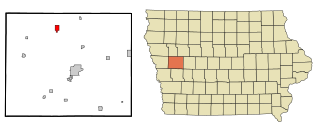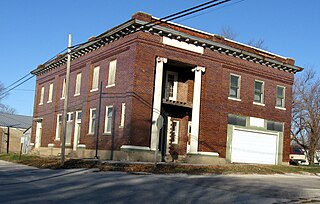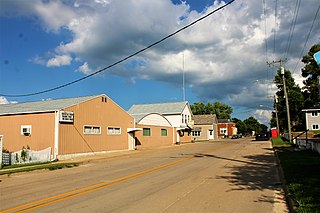
Woodburn is a city in Clarke County, Iowa, United States. The population was 146 at the time of the 2020 census.

Schleswig is a city in Crawford County, Iowa, United States. The population was 830 at the time of the 2020 census.

Orleans is a city in Dickinson County, Iowa, United States. The population was 521 at the time of the 2020 census. Orleans is part of the Iowa Great Lakes region, located along Spirit Lake. Numerous state parks are located within a few miles of the town, including Marble Beach and Mini-Wakan.

Lockridge is a city in Jefferson County, Iowa, United States. The population was 244 at the time of the 2020 census. Lockridge was one of the communities considered for the county seat in 1839, but lost out to Fairfield.

Dixon is a city in Scott County, Iowa, United States. The population was 202 at the time of the 2020 census.

North Muskegon is a city in Muskegon County in the U.S. state of Michigan. The population was 3,786 at the 2010 census.

Vermillion is a city in Dakota County, Minnesota, United States. The population was 441 at the 2020 census.

Woodland is a community in Hennepin County, Minnesota, United States, with lake shore property on Lake Minnetonka. The population was 437 at the 2010 census. The first settlers arrived in 1857, when Woodland was part of Minnetonka Township. The land was formally platted in 1882 and developed through the 1890s. Woodland was incorporated as the independent village of Maplewoods in December 1948. It was renamed "Woodland" in 1949.

Sunburg is a city in Kandiyohi County, Minnesota, United States. The population was 100 at the 2010 census.

Pine Springs is a city in Washington County, Minnesota, United States. The population was 408 at the 2010 census.

Goodview is a city in Winona County, Minnesota, United States. The population was 4,158 at the 2020 census.

Lamar Heights is a city in Barton County, Missouri, United States. The population was 170 at the 2020 census.

Freeman is a city in Cass County, Missouri, United States. The population was 482 at the 2010 census. It is part of the Kansas City metropolitan area.

Cave is a populated place in Lincoln County, Missouri, United States. The population was 5 at the 2010 census. With a 2020 population of 5, it is the 939th largest city in Missouri and the 19481st largest city in the United States. Cave is currently declining at a rate of 0.00% annually and its population has decreased by 0.00% since the most recent census, which recorded a population of 5 in 2010.

Pleasant Hope is a city in Polk County, Missouri, United States. The population was 614 at the 2010 census. It is part of the Springfield, Missouri Metropolitan Statistical Area.

Minnewaukan is a city in Benson County, North Dakota, United States. It serves as the county seat and is fourth largest city in the county, after Fort Totten, Leeds, and Maddock. The population was 199 at the 2020 census. Minnewaukan was founded in 1884.

Sublimity is a city in Marion County, Oregon, United States. The population was 2,967 at the 2020 census. It is part of the Salem Metropolitan Statistical Area.

Worthington is a town in Marion County, West Virginia, United States. The population was 158 at the 2010 census. Worthington was incorporated in 1893 and named for Colonel George Worthington, an early settler. U.S. Route 19 passes through the town.

War is a city in McDowell County, West Virginia, United States. The population was 690 at the 2020 census. War was incorporated in 1920 by the Circuit Court of McDowell County. Its name is derived from War Creek, whose confluence with Dry Fork is located within the city. War is the only place in the United States with this name. War was formerly known as Miner's City. It is also known for being a setting in the movie October Sky; as writer Homer Hickam's Big Creek High School.

Minneiska is a city in Wabasha and Winona counties in the U.S. state of Minnesota. The population was 111 at the 2010 census.























